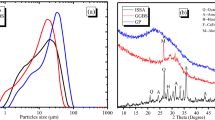Abstract
The dissolution rate of a simulated Magnox waste glass has been investigated in single-pass flow-through experiments designed to investigate the role of Al and Si in the dissolution process. The results indicate that both Al and Si species suppress the rate of dissolution. These effects may be modelled using a combined Al/Si affinity term in a conventional glass dissolution rate law. Aluminium species may also play an inhibitory role when present at relatively high solution activities. In Si-rich alkaline media, the concentration of aluminium is controlled to very low levels by the development of secondary aluminosilicate phases. Removal of Al by secondary phase precipitation results in dissolved Al activities below that required to reach ‘saturation’ with respect to the glass.
Similar content being viewed by others
References
A. C. Lasaga in Kinetics of Geochemical Processes ed. A. C. Lasaga and R. J. Kirkpatrick, Reviews in Mineralogy 8, chapter 4, p. 135–169 (1981).
P. Aagaard and H. C. Helgeson, Am. J. Sci. 282 (1982) p. 237–285.
A. C. Lasaga in Chemical Weathering Rates of Silicate Minerals, eds. A. F. White and S. L. Brantley, Reviews in Mineralogy 31, chapter 2, p. 23–81 (1995).
B. Grambow, Mat. Res. Symp. Proc. Vol. 44 (1985), p. 209–216.
W. L. Bourcier, D. W. Peiffer, K. G. Knauss, K. D. McKeegan and D. K. Smith, Mat. Res. Symp. Proc. Vol. 176 (1990), p. 209–216.
S. Gin, Mat. Res. Symp. Proc. Vol. 412 (1996), p. 189–196.
V. Daux, C. Guy, T. Advocat, J. L. Crovisier and P. Stille, Chemical Geology Vol. 142 (1997) p. 109–126.
T. Advocat, J. L. Chouchan, J. L. Crovisier, C. Guy, V. Daux, C. Jegou, S. Gin and E. Vernaz, Mat. Res. Symp. Proc. Vol. 412 (1998), p. 63–70.
B. P. McGrail, W. L. Ebert, A. J. Bakel and D. K. Peeler, Journal of Nuclear Materials, Vol. 249 (1997), p. 175–189.
ASTM, Standard Test Methods for Determining the Chemical Durability of Nuclear Waste Glasses: The Product Consistency Test (PCT), ASTM C 1285-94, Annual Book of ASTM standards, Philadelphia, PA (1994).
D. L. Parkhurst, U. S. Geological Survey, Water-Resources Investigations Report 95-4227 (1995).
P. K. Abraitis, D. J. Vaughan, F. R. Livens, J. Monteith, D. P. Tnivedi and J. S. Small, Mat. Res. Symp. Proc. Vol. 412 (1998), p. 47–54.
B. F. L. Smith in Clay Mineralogy: Spectroscopic and Chemical Determinative Methods. ed. M. J. Wilson, chapter 9, p. 331–357 (1994).
P. Van Iseghem, T. Amaya, Y. Suzuki and H. Yamamoto, Journal of Nuclear Materials, Vol. 190 (1992), p. 269–276.
Author information
Authors and Affiliations
Corresponding author
Rights and permissions
About this article
Cite this article
Abraitis, P.K., McGrail, B.P. & Trivedi, D.P. The effects of silicic acid, aluminate ion activity and hydrosilicate gel development on the dissolution rate of a simulated British Magnox waste glass. MRS Online Proceedings Library 556, 401 (1998). https://doi.org/10.1557/PROC-556-401
Published:
DOI: https://doi.org/10.1557/PROC-556-401




